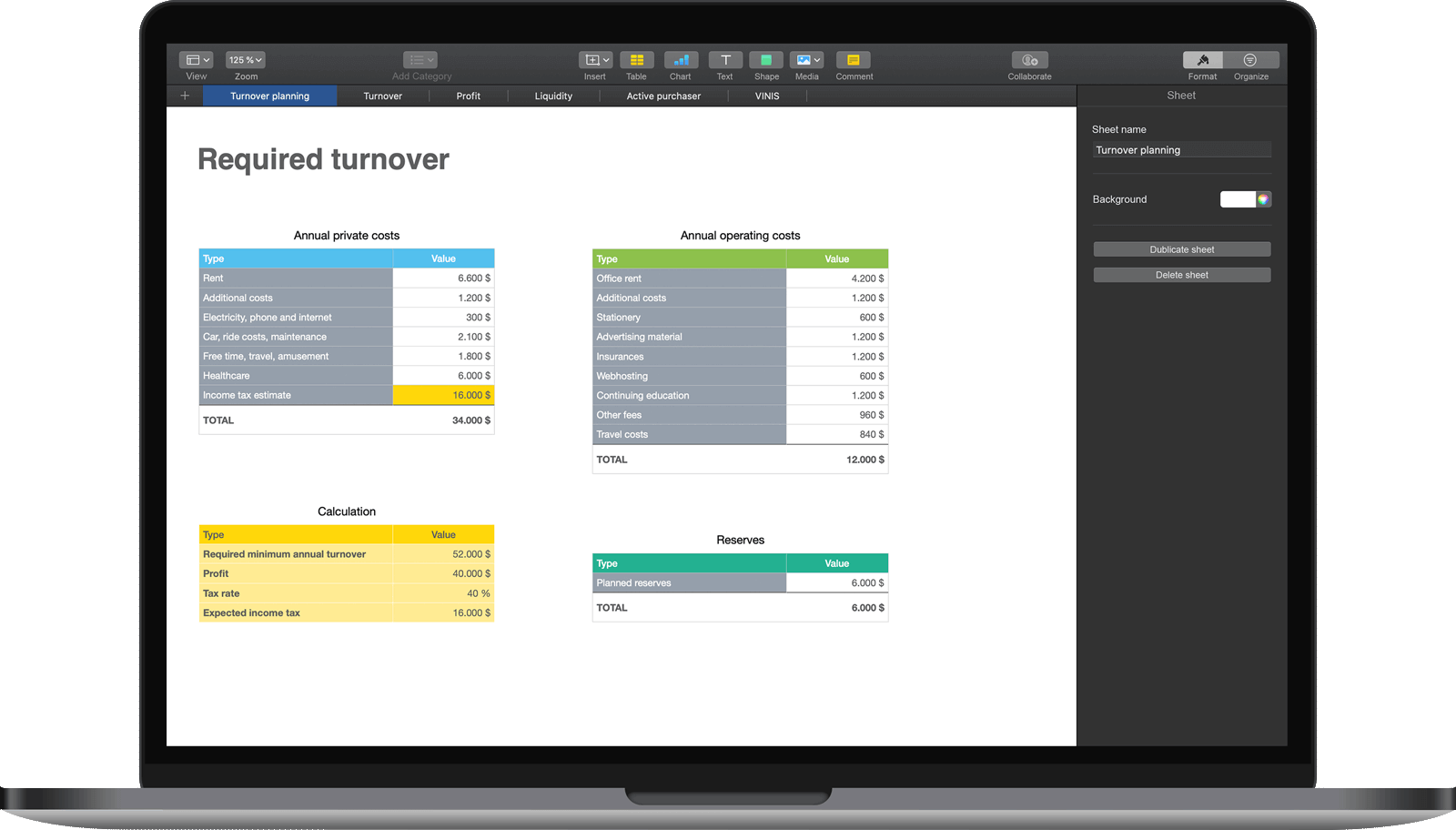More and more people feel the great desire for professional independence. Being your own boss, flexible working hours and lots of variety are some of the many advantages of self-employment. But in order to enjoy these advantages in the long run, you have to reach certain goals. Probably the most important goal concerns your turnover. How much do I have to earn to be able to live from self-employment? We will address this answer directly in our example goal.
Self-employed as?
In order to be able to formulate a concrete goal, you must be clear about what you want to be self-employed with. For our example, let’s assume you are a software developer and now want to make your work available as a freelancer. Of course, this can also be applied to other professions and possibilities of self-employment.
The turnover
To make ends meet as a freelance software developer, you need a certain minimum turnover to cover your costs. In addition, there should be a profit left over. We will take a closer look at how to calculate this amount and what you should pay attention to. For our example, we will use this amount in the goal formulation.
Determine a deadline
Finally, you should consider by when you want to put your goal into action. This depends on your current life situation and how fast you can take the first step. Try to make a realistic estimate here and write down the deadline by which you want to have achieved your goal.
The concrete goal
We now have all the information for our goal, which could be as follows:
“As a self-employed software developer, I achieve a turnover of 52,000 $ for the year 2021”.
Your deadline would therefore be 31.12.2021. You should always formulate your goal personally, positively and in the present tense.
Measure your progress
The next step is to define metrics that you can use to measure your progress. It is important to recognize as early as possible whether you are approaching your goal or whether you are going off track. Only then can you react in time and, if necessary, take appropriate action.
Our most important key figure shows us the turnover for the current year. As explained above, you can only be successful in the long term if you can cover your costs. For this purpose, we create a target key figure, which is also your main key figure. The target value of this key figure is determined by your costs and the desired profit. For our example we take a value of 52,000 $. We provide you with an Excel and Numbers template that you can use to calculate these values and transfer them directly into the VINIS app. More information about the template can be found below. The current value of this key figure is your achieved revenue for the current year.
The second key figure we define is the sales forecast for the current year. Using the sales forecast, we want to include all orders for the year that are as certain and foreseeable as possible in addition to the sales already generated. If, for example, you are in January and a company will almost certainly commission you by the middle of the year, you will find this amount in the key figure. So you not only know how much you have already taken in, but you can also see how much you will take in as of now. To be able to map this, we also create a target key figure and set the target value to our planned revenue.
So that you can see how your self-employment is developing in the long term, we define sales growth as the third key figure. Here we compare the sales from the current year with those from the last. For this we use a growth key figure. The current value of this key figure is always your current turnover. The sales of the last year are taken as the original value. This key figure only makes sense if you have already achieved sales in the previous year. If you are just starting your own business, you can leave out this key figure for the time being. Of course, you can add it back later at any time.
In order to cover your private expenses and to build up reserves, it is important to make a profit. You should not only cover your costs, but also have something left over in the end. We want to record this profit with the next key figure. Since we can only calculate the exact profit correctly after the year has ended, we will define a profit forecast as a key figure. To calculate it, we’ll take the sales forecast and subtract your operating costs from it. To map this, we use a value key figure.
Since your projected costs will also be incurred and debited at some point, you should always have enough money in your account. We want to map these liquidity reserves with another key figure. This allows you to see at an early stage whether you still have enough money to pay bills and, if necessary, to react accordingly. Here we also use a value key figure, which visualizes the current available amount.
Finally, we want to record the number of your currently active clients/customers via a key figure. The higher the value, the more stable is the foundation of your self-employment. If a client drops out in the short term, the impact on several clients is less serious than if a single large client should drop out. A value key figure can be used for this purpose.
Data collection
With the above defined key figures you now always have a good overview of the current status of your self-employment. What is missing now is the appropriate data for your key figures. The easiest and fastest way is to enter them directly in the app.
In the long run, however, it is recommended to maintain larger amounts of data in an external tool and to track and visualize the key figures via the VINIS app. One option would be to use Excel or Numbers and create a document in which all data on self-employment is maintained. We would like to support you here and provide you with an Excel and Numbers template.

Our flexible key figures allow you to access external data from the VINIS app. You only have to enter new values in the document and the VINIS app can retrieve and update these data via an automated export. You can find instructions on how this works here.
If your business grows in the future and you have several employees, a special software to manage the data (e.g. a CRM system) makes sense. But you can also access it from the VINIS app, so you can track your metrics and keep an eye on your goals.

